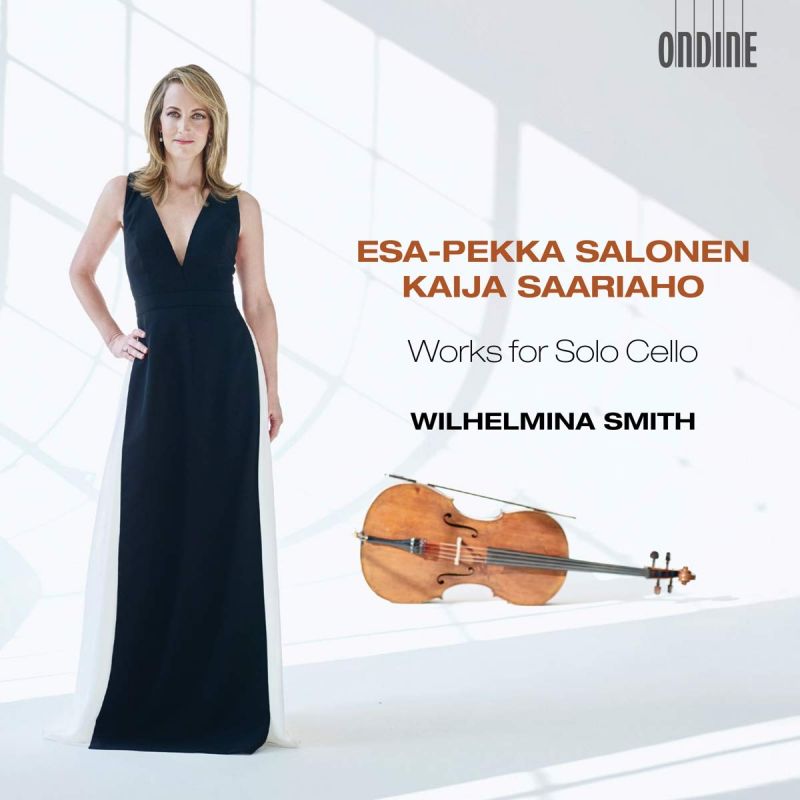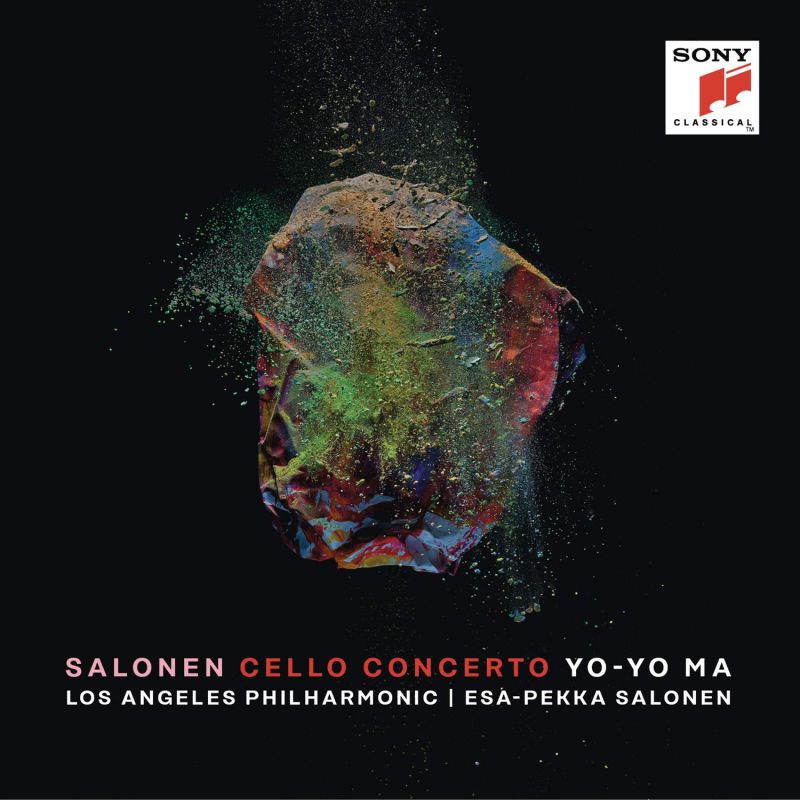SALONEN Works for Cello (Wilhelmina Smith; Yo-Yo Ma)
View record and artist detailsRecord and Artist Details
Composer or Director: Kaija Saariaho, Esa-Pekka Salonen, Giuseppe Colombi
Genre:
Instrumental
Label: Ondine
Magazine Review Date: 05/2019
Media Format: CD or Download
Media Runtime: 59
Mastering:
DDD
Catalogue Number: ODE12942

Tracks:
| Composition | Artist Credit |
|---|---|
| Yta III |
Esa-Pekka Salonen, Composer
Esa-Pekka Salonen, Composer Wilhelmina Smith, Cello |
| knock, breathe, shine |
Esa-Pekka Salonen, Composer
Esa-Pekka Salonen, Composer Wilhelmina Smith, Cello |
| Sarabande per un coyote |
Esa-Pekka Salonen, Composer
Esa-Pekka Salonen, Composer Wilhelmina Smith, Cello |
| Chiacona |
Giuseppe Colombi, Composer
Giuseppe Colombi, Composer |
| Dreaming Chaconne |
Kaija Saariaho, Composer
Kaija Saariaho, Composer Wilhelmina Smith, Cello |
| Petals |
Kaija Saariaho, Composer
Kaija Saariaho, Composer Wilhelmina Smith, Cello |
| (7) Papillons |
Kaija Saariaho, Composer
Kaija Saariaho, Composer |
| Spins and Spells |
Kaija Saariaho, Composer
Kaija Saariaho, Composer Wilhelmina Smith, Cello |
Composer or Director: Esa-Pekka Salonen
Genre:
Orchestral
Label: Sony Classical
Magazine Review Date: 05/2019
Media Format: CD or Download
Media Runtime: 35
Mastering:
DDD
Catalogue Number: 19075928482

Tracks:
| Composition | Artist Credit |
|---|---|
| Concerto for Cello and Piano |
Esa-Pekka Salonen, Composer
Esa-Pekka Salonen, Composer Esa-Pekka Salonen, Composer Los Angeles Philharmonic Orchestra Yo-Yo Ma, Cello |
Author: Andrew Mellor
That principle is at work in the Saariaho played here. Typically, she is interested in corners of the cello’s voice: harmonics, distortion and how those things, particularly in Petals (1988), lead naturally to rebirth. The problem, as so often with instrumental music from this composer, is a tendency to obsess over the same devices: bow strokes that move from gentle to abrasive; tremolandos that shiver away before exploding.
The multi-movement structure of Sept Papillons (2000) distracts Saariaho enough to mean those recurring devices don’t grate as they do in Spins and Spells (1997), where the momentary ascents tire and we only occasionally sense the arcane beauty of the new tuning system she applies. There are some gorgeous moments in Papillons and particularly in Saariaho’s reinvention of the Giuseppe Colombi Chaconne, Dreaming Chaconne, where the harmonic relations are sufficiently un distorted and the focus is clear. The question is whether you feel the composer’s insistence on sounds other than resonant bow strokes is willingly contrary or satisfyingly consistent. I for one struggle with it.
Given their design, repetitions in Salonen’s work feel all the more developmental and cumulative. The composer’s own take on the Colombi Chaconne (31 composers in all wrote a response to the work for the cellist Anssi Karttunen) locks in to his way with patterning and textiles, even if he takes it to rough and tough places in Sarabande per un coyote (2010). Salonen wrote YTA III (1986) with the express desire to yank the listener in with one level of action (there’s also a handy narrative: an organism in its dying moments). None of the above stops the piece being complex but the surface message hides it (one mark of a worthy piece).
Again, that’s connected to Salonen’s compositional style but also to his many hours unravelling scores by Ligeti and Lutosawski and presenting them in front of audiences. Patterning, diatonic motifs and room-stilling lyricism populate knock, breathe, shine (2010) but there is flair as well. Where Salonen uses harmonics in ‘breathe’, it’s as an evocation of something from before glimpsed again. Smith plays everything here with captivating expression; her sound has both bold lustre and gossamer delicacy.
Salonen created something big from small means in that piece, a truly Nordic conceit. But he sensed it could be something bigger, and elements of both ‘breathe’ and ‘shine’ made it into the composer’s Cello Concerto (2017) for Yo Yo Ma. A few features distinguish this work: its constant mobility and directional movement, fuelled by a variety of rhythmic stimuli; its singular spaciousness resulting from delectable, deep orchestration; and the sense that a force of nature lies behind its combination of runic shamanism and scientific logic.
‘I like the concept of a simple thought emerging from a complex landscape’, writes Salonen in the booklet. Where the simple thought of the soloist’s first utterance in Sibelius’s Concerto arrives as if into a forest clearing, in Salonen’s it emerges into a huge cosmic space before shooting off, with cyclic imitation trailing like a comet’s tail behind (notably from the cor anglais). The movement gets quieter as it gets more intense.
The second movement opens with another big bang while the exquisite harmonic clusters at the other end are surely descended from Rautavaara. The rhythmic impetus already mentioned feeds the third movement, pumping its increasingly erratic breathing and eventually driving it into some planet or other before the cadenza. Ma sweeps through the work as if in a single breath, no less bold than Smith and with a charisma that carries the music and the listener along. Not easy, given Salonen’s determination to push soloists out on to a high wire. But it says something about composer and performer(s) that technical derring-do is not what you come away with.
Discover the world's largest classical music catalogue with Presto Music.

Gramophone Digital Club
- Digital Edition
- Digital Archive
- Reviews Database
- Full website access
From £8.75 / month
Subscribe
Gramophone Full Club
- Print Edition
- Digital Edition
- Digital Archive
- Reviews Database
- Full website access
From £11.00 / month
Subscribe
If you are a library, university or other organisation that would be interested in an institutional subscription to Gramophone please click here for further information.




